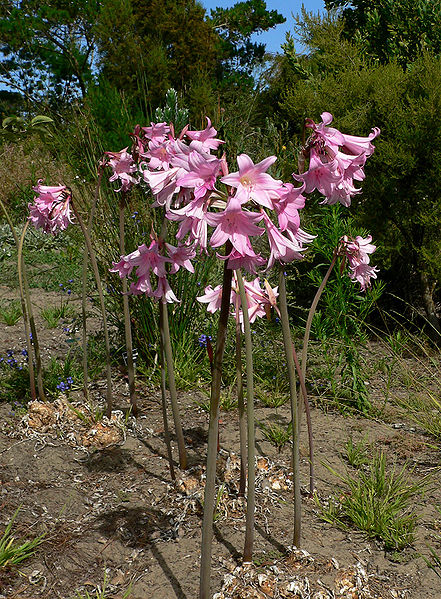3 Plants With Pink Flowers On Long Stems With No Leaves
Have you found an unknown plant with pink flowers on long, upright, leafless stems and you want to identify it? Here are several flowering plants that fit this description.
A plant is usually easily identifiable either by its leaves, flowers, or fruits. However, when it doesn’t have fruits, and not even leaves, all we can use to determine its species are its blooms.
Below are several plant species that produce flowers supported by long stems and which have no leaves during their blooming period.
1. Belladonna Lily (Amaryllis Belladonna)
Belladonna lily (Amaryllis belladonna), also commonly known as the Jersey lily, March lily, or naked-lady lily, is a flowering plant in the genus Amaryllis. It is native to South Africa and is widely cultivated as an ornamental plant for its beautiful blooms throughout the world.

Amaryllis belladonna is a perennial, bulbous plant. One to two erect, solid, and leafless stems emerge in late summer from the underground bulb.
In the upper part of the stems, it develops the inflorescences formed from 2 to 12 large, fragrant, pink funnel-shaped flowers (up to 10cm in length) that bloom in the fall, before the narrow, strap-shaped leaves appear. Hence, its common name of “naked-lady-lily.”
All the parts of this plant are toxic for humans and animals. They contain several different alkaloids, such as lycorine, amaryllidine, and pancracine.
2. Resurrection Lily (Lycoris Squamigera)
Resurrection lily (Lycoris squamigera) is a bulbous perennial plant in the family Amaryllis (Amaryllidaceae). It is native to Asia but grown worldwide as an ornamental plant. It is also commonly known as the surprise lily or magic lily.

The resurrection lily produces large, white or pink, fragrant inflorescences formed from 4 to 7 trumpet-shaped flowers that are supported by long, leafless, and sturdy stems. The inflorescences arise suddenly from the ground and fully bloom in just a few days, leading to its familiar names of resurrection lily, magic lily, or surprise lily.
The leaves of Lycoris squamigera sprout and develop in the spring, then die back during June, before the plant produces the blooms. The blooms occur typically in late July or early August when the plant has no leaves.
The resurrection lily can be easily mistaken for other similar-looking flowers also with erect, long, and leafless stalks like Amaryllis belladonna or some species of Colchicum. All of them are generally referred to as “naked ladies.”
3. Autumn Crocus (Colchicum Spp.)
Colchicum is a genus of perennial plants that grow from corms. It contains more than 100 species of flowering plants, and many of them are collectively known under names like the autumn crocus, meadow saffron, or naked lady (name also used for other plants that produce flower stalks with no leaves).

The plants in this genus produce flowers that look similar to the ones in the genus Crocus. The flowers emerge in late summer or in fall before the foliage of the plant appears.
Depending on the species, the flowers can have various colors such as pink, purple, yellow, or white. The predominant colors are pink and purple. The blooms are supported by erect, unbranched, and leafless stalks.
Some species of Colchicum are grown as decorative plants for their attractive flowers.
The plants in this genus contain a toxin called colchicine.
Final Word
These are several plant species that produce pink or purplish flowers on upright, unbranched, leafless, long stalks.
These plants stand out not only by their large, colorful and attractive flowers, but also by the fact that they do not have leaves during the blooming period. Their flowers, growing from bulbs or corms, pierce the surface of the soil and occur suddenly, then develop long flowering stalks with inflorescences in their upper side.
We hope that you found this article helpful in identifying the plant species with these particularities and the next time you see a plant with pink blooms on long, leafless stalks that emerge straight from the ground, you should be able to recognize it easily.
If you need additional help with identifying an unknown plant, we recommend you take a look at our list of phone apps for identifying plants.

